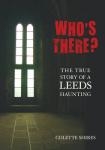
Reviewed by Tom Ruffles
Colette Shires has produced a fascinating account of persistent paranormal phenomena which she says plagued her family from 1958, when they removed to a house in Grant Street (now demolished), off Roundhay Road in Leeds, and even after they were forced to leave it in dramatic circumstances nine years later. The experiences, a huge number in total, ranged from the strange – a baby crying where there wasn‘t one, footsteps, objects disappearing and only sometimes turning up again, for example – to the bizarre and frightening, including several full-form apparitions.
The most striking of these was a ghastly episode when Colette was trying to take a dress out of her wardrobe but meeting some resistance and, putting her hands in, felt “something soft but solid” which when she pulled the clothes to one side turned out to be the ghost of a man in a striped jacket crouching among them. It says something for her self-control that she could still go to a works’ do and, as the photograph taken that evening which she includes suggests, act as if nothing untoward had happened.
These unsettling incidents culminated in August 1967, when the house partially collapsed early one morning. Nobody was injured but the house was uninhabitable and Colette’s parents had to be rehoused. They moved to Potternewton in Leeds, but the ghosts followed. Later Colette’s mother’s had a terrible accident and eventually lived in a number of residential homes where she had the company of what seemed to be an invisible friend that followed her as she moved from home to home – until another resident claimed to have seen her too. At the same time Colette’s father, now on his own in the Potternewton house, still encountered paranormal phenomena, and remarkably suffered a similar problem with the floor to the one that had caused the catastrophe in Grant Street.
The paranormal events were clearly person- rather than place-centred, as they followed her parents when they moved, leaving Colette wondering where they might turn up next. Ordinary objects – a tin trunk, a display cabinet – came to be regarded with suspicion as possibly acting as carriers for some kind of paranormal contamination. There is also no sense of closure, in that there is always the feeling that the ghosts, not having a defined reason for appearing in the first place, could return without the family knowing why. More to the point, once present, there seemed to be no way of getting rid of them. Her mother’s Catholic faith was not enough, and blessings by clergy proved ineffectual.
Running alongside the ghost story is also the story of Colette’s transition from child to young woman in the Swinging 60s, the ups and downs of marriage and the confidence that comes with managing her own life. It is a warm portrait of a closely-knit Anglo-Irish family getting on with their lives, and not allowing their strange experiences to dominate them, unlike many families in similar circumstances. The ordinariness of domestic life makes the paranormal aspect all the more unnerving.
Nothing here is going to convince a sceptic, but it is a straightforward and sincere narrative. The author employs a lot of dialogue that has to be approximate, but it seems authentic enough. A couple of statements from family members have been included, but there are no contemporaneous notes, nor independent witness statements, leaving the reader no way to assess the accuracy of Colette’s story. The family tried to keep the thing to themselves, which is understandable if they feared neighbours’ gossip, but it does mean that the reader has to accept Colette’s memories going back over fifty years. The way it is told seems credible, which makes it all the more frustrating that there is so little corroboration.

